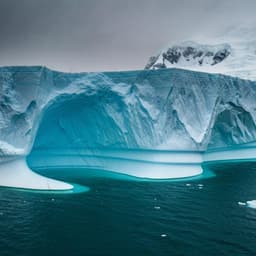
Earth Sciences
Record high Pacific Arctic seawater temperatures and delayed sea ice advance in response to episodic atmospheric blocking
T. Kodaira, T. Waseda, et al.
This study by Tsubasa Kodaira, Takuji Waseda, Takehiko Nose, and Jun Inoue reveals astonishing findings about the record high seawater temperatures in the Pacific Arctic in autumn 2018 and their impact on sea ice advance. Unraveling the effects of unusual warm water from the Bering Sea, this research points to a significant delay in ice formation, with implications for future Arctic conditions.
~3 min • Beginner • English
Introduction
The Arctic has warmed at more than twice the global average in recent decades (Arctic amplification), with implications for atmospheric and oceanic circulation and mid-latitude extreme weather. Multiple mechanisms contribute to Arctic amplification, including ice–albedo feedback, increased downward longwave radiation from low-level clouds, and feedbacks between ocean turbulent heat flux and the lower troposphere. Remote forcings from lower latitudes via atmospheric heat and moisture transport and oceanic heat transport also play important roles, and their interactions create a highly nonlinear climate system. Arctic sea ice extent is a key component of the Arctic climate and is influenced by both atmosphere and ocean. The Arctic Ocean exchanges water and heat with adjacent oceans; while Atlantic inflow carries more total heat, the Pacific inflow, though smaller, is impactful because it enters nearer the surface via the shallow Bering Strait, crosses the Chukchi Sea, and intrudes subsurface into the western Arctic basin. Recent decades show significant subsurface warming of Pacific-origin water in the western Arctic. Oceanic heat has a more direct impact on sea ice in shallow marginal seas such as the Chukchi and Bering, where heat acts directly on the ice. Prior work linked seawater temperature anomalies to early winter sea ice cover in these seas and suggested Pacific inflow can trigger sea ice reductions via feedbacks enhancing wind-driven export. This study focuses on Pacific water inflow to the Arctic in relation to sea ice advance, centered on the Chukchi Sea where warming trends, reduced seasonal ice cover, and high productivity have been documented. The sea-ice-covered period over the Chukchi Sea correlates with heat inflow through Bering Strait, which depends on both volume transport and source water temperatures, and is influenced by winds and pressure head differences. Here, satellite SST, atmospheric reanalysis, and direct R/V Mirai observations are combined to evaluate interannual variability during sea ice formation months and to investigate why autumn 2018 SSTs were record high despite a neutral PDO.
Literature Review
Background literature identifies key contributors to Arctic amplification: ice–albedo feedback due to the contrast between multiyear ice and open water albedo; increased downward longwave radiation from low-level clouds; and a positive feedback between ocean turbulent heat flux and atmospheric longwave forcing. Remote forcings include transports of heat and moisture by the atmosphere and heat by the ocean from lower latitudes. The Pacific inflow, though smaller than Atlantic inflow, significantly affects sea ice because it enters the Arctic near the surface via the Bering Strait and traverses the shallow Chukchi Sea. Previous studies reported subsurface warming of Pacific-origin waters in the western Arctic, strong impacts of poleward heat flux on marginal seas’ sea ice, and relationships between early-winter SSTs and sea ice cover in the Barents and Bering seas. The Chukchi Sea’s sea-ice-covered period has been correlated with Bering Strait heat inflow, which varies with volume transport and source SST and is influenced by regional atmospheric conditions, including winds over the East Siberian Sea that affect pressure head. Case studies showed both transport and source temperature contribute to Bering Strait heat inflow. Literature on atmospheric blocking has shown impacts on Atlantic multidecadal variability and Fram Strait sea ice export; however, prior to this work, impacts of Pacific-side blocking on autumn sea ice growth in the Pacific Arctic had not been reported. PDO is a dominant mode of decadal North Pacific SST variability, generally correlating with warmer SSTs in the study area during its positive phase, but its relationship with Alaskan blocking is weak.
Methodology
The study integrates satellite, reanalysis, autonomous float, and ship-based observations. SST and SIC: Daily 1/10° SST and SIC fields from AMSR-E (2002–Sep 2011) and AMSR2 (Oct 2012–2018) were obtained from the Arctic Data archive System. Monthly means were computed excluding missing data. Spatial averages were computed over the Chukchi Sea (65–75°N, 160–180°W) and northern Bering Sea (55–65°N, 160–180°W); SST values near sea ice and coasts were excluded from averages. PDO: Monthly PDO index values (poleward of 20°N SST leading principal component) were downloaded from Dr. Mantua’s website; annual means were formed from monthly values (for 2018, January–September mean). Atmospheric reanalysis: ERA5 (0.25°) reanalysis (1979–2018) provided winds, air–sea heat flux components (latent, sensible, net solar, net thermal), and geopotential height at 500 hPa (z500) for identifying blocking following established criteria. Mean sea level pressure anomalies were also analyzed. Turbulent heat flux was defined as the sum of sensible and latent heat fluxes; positive downward. Argo float: Vertical profiles of temperature and salinity from Argo float #4902926 drifting in the central Chukchi Sea (2018; 40–60 m depths) were used to document seasonal mixed layer and upper ocean heat evolution. Ship observations: R/V Mirai MR18-05C (4–24 Nov 2018) conducted continuous near-surface atmosphere and ocean measurements via SOAR (air temperature and wind at 25 m; seawater temperature and salinity at 5 m; 5-min averages for visualization) and shipboard ADCP (75 kHz; 30-min averages). CTD casts (SBE9plus) provided profiles; mixed layer depth was defined where potential density exceeds near-surface (5–10 m mean) by 0.1 kg/m³. SAR: Sentinel-1A/B Level-2 normalized radar cross-section data (NOAA CoastWatch products) were interpolated to 1/500° grids to estimate sea ice extent near the study area. Analyses included correlation of SST with PDO, computation of SST anomalies and heat flux anomalies relative to 1979–2018 means, assessment of September 2018 wind anomalies over the Bering Strait, estimation of wind-driven Bering Strait transport anomaly, and simple advection arguments linking wind anomalies, transport, and source SST.
Key Findings
- November SSTs over the Chukchi and Bering seas reached their highest values in the 2002–2018 record in 2018.
- November SSTs correlate with annual mean PDO index (r ≈ 0.7; p < 0.05) for both seas, but 2018 is an outlier; removing 2018 increases correlation strength.
- In 2018, SSTs remained nearly unchanged from August to September, unlike typical cooling by several degrees, indicating persistence of warm conditions into autumn.
- September 2018 featured an anomalous southerly wind over the Bering Strait of about 5 m/s, associated with a persistent atmospheric blocking high over the Bering Sea.
- The 5 m/s southerly wind anomaly corresponds to an additional ~0.70 Sv Bering Strait transport, substantial relative to mean annual (September) transports of 1.03 Sv (0.99 Sv) for 2003–2015.
- The September 2018 500 hPa geopotential height anomaly over the Bering region was ~+180 m, exceeding four standard deviations above the 1979–2018 September mean, indicating an episodic blocking event; correlations between z500 and PDO were weak (maximum ~0.42).
- Surface heat flux anomalies from August–October 2018 averaged only +2.2 W/m² over the Chukchi Sea, equivalent to ~0.1 °C warming for a 40 m surface mixed layer, implying air–sea heat fluxes contributed little compared with wind-driven advection.
- R/V Mirai observations in early November 2018 documented an ~40 m thick warm surface mixed layer; its heat content could delay sea ice advance by ~74 days under a constant −94 W/m² November climatological surface heat flux.
- Despite strong off-ice northeasterly winds (>10 m/s) and sub −10 °C air during 17–21 November, sea ice advance was minimal as SSTs remained above the freezing point (−1.8 °C).
- Shipboard ADCP recorded sustained ~0.12 m/s currents over 10 days, implying ~100 km warm water advection toward the MIZ; salinity profiles supported horizontal advection as a warming mechanism.
- Regionally, sea ice concentration increased after 8 November but its southward advance slowed markedly between 13 November and 4 December 2018 while SSTs dropped by ~3 °C due to enhanced turbulent heat fluxes.
- November 2018 air–sea heat release over the Chukchi Sea was significantly higher than the 1979–2018 mean due to anomalously warm, open-water conditions.
Discussion
The study demonstrates that a persistent atmospheric blocking high over the Bering Sea in September 2018 drove anomalous southerly winds across the Bering Strait, enhancing Pacific inflow volume transport and advecting warm water into the Chukchi Sea. This rapid oceanic response led to record-high autumn SSTs and a substantial delay in sea ice advance in November 2018, despite atmospheric conditions favorable for freezing. The findings clarify that while PDO modulates interannual SST variability, episodic atmospheric blocking can dominate the seasonal outcome, independent of PDO phase. This is the first evidence that Pacific-side atmospheric blocking significantly modulates autumn sea ice growth in the Pacific Arctic by altering ocean heat inflow. Broader implications include ecosystem impacts (e.g., seabird mortality linked to warm periods, effects on ice-dependent mammals), enhanced heat transport into the Arctic basin during longer ice-free periods, and potential influences on mid-latitude weather via increased upward heat flux altering jet stream pathways. The results suggest that if similar blocking occurs during a PDO positive phase, additive effects could yield >2 °C SST increases and dramatic reductions in annual maximum Arctic sea ice extent. Improved characterization of oceanic heat transport pathways, including turbulent fluxes by eddies near the shelf break and MIZ, is needed to better predict sea ice and associated sea states relevant for Arctic navigation.
Conclusion
The study identifies an episodic atmospheric blocking high over the Bering Sea in September 2018 as the primary driver of record-high autumn SSTs in the Chukchi and Bering seas and the delayed sea ice advance in November 2018, overriding the typical PDO influence. Warm Pacific water intrusion, maintained by anomalous southerly winds and horizontal advection, stored sufficient heat in a ~40 m surface mixed layer to resist freezing under strong cold-air outbreaks. These results highlight the critical role of short-term atmospheric circulation anomalies in controlling Pacific–Arctic ocean heat transport and sea ice seasonality. Future work should focus on monitoring late-summer atmospheric conditions for seasonal prediction, refining representations of Pacific-to-Arctic ocean heat transport (including eddy-driven turbulent exchanges), integrating multi-platform observations, and assessing compound effects when atmospheric blocking coincides with PDO positive phases.
Limitations
The analysis centers on a single episodic event (2018) within a relatively short satellite record (from 2002) and relies on reanalysis products for atmospheric and surface flux estimates. The AMSR dataset has a data gap in late 2011–2012. Causal links between Arctic anomalies and mid-latitude weather remain uncertain due to the small sample of years with large sea ice loss. Simple advection arguments are used for interpretive estimates, and detailed quantification of turbulent oceanic heat fluxes by eddies is not resolved.
Related Publications
Explore these studies to deepen your understanding of the subject.







